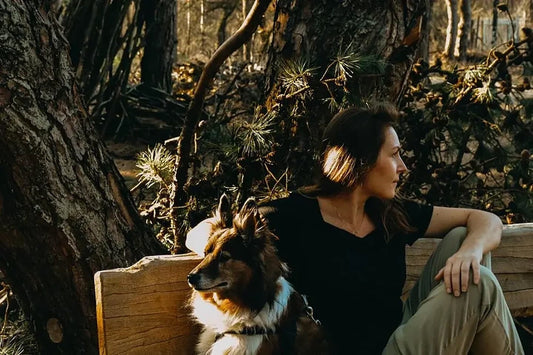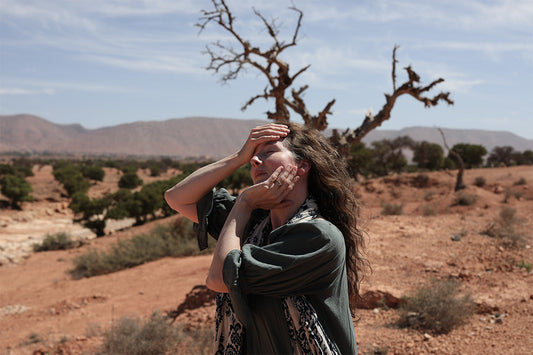Is there any plant more historically revered than sandalwood?
Each culture that has come in contact with this fragrant wood has recognized its sacred qualities. It seems to summon, or perhaps simply awaken us to Divine Presence. From the Qu’ran to the Bhagavad Gita and the Old and New Testaments (where it was commonly referred to as aloes) it has graced the pages of holy texts — both with its name and as the very ink that scrawled the verses. From birth and burial rituals, to the building of temples and the carving of deity statues and prayer beads, sandalwood is known to thin the veils between this world and the next. In India, the honor of one’s life is measured by the amount of sandalwood they are cremated with.
Sandalwood is also one of the few plants that is considered to possess qualities both meditative and transcendent, medicinal and preservative, as well as sensual and aphrodisiac. Its mesmerizing scent of creamy caramelized woods and its profound ability to unify, ground, and elevate has captivated humans for many thousands of years.
Shirley-Jo smelling Sandalwood
Sandalwood and roots
Háloa Áina
Evanhealy’s partnership with Háloa Áina, a Hawaiian sandalwood reforestation project and education organization, is a great example of our commitment to partner with organizations which strive to preserve cultural and ecological values. We recognize that sourcing sandalwood oil and hydrosol from this noble project is critical to the flourishing of the local ecosystem.
When we first met Wade Lee, founder of Háloa Áina, we could smell the delicious, creamy aroma of sandalwood emanating from him. Lee, a former biologist as well as physics and chemistry university professor, chuckled and said he has been so permeated with sandalwood that he can’t smell it anymore. We met him at the beginning of a large swathe of privately-owned corporate lands on Hawai’i’s Big Island, most of it former ranch land that had been previously slashed and burned for cattle use and was now planted with coffee and other products. As we drove along the dirt road to the Háloa Áina property, he enthusiastically explained the biology and history of royal Hawai’ian sandalwood. In the distance, we could see Mauna Loa, the volcanic mountain, which had just stopped erupting three days earlier. Unlike many of the commercially-used lands around the Háloa Áina property, Lee focuses on organic, sustainable processes and maintaining the natural balance of the native ecosystem. As he often reminded us, his project is neither a farm or a ranch, but a reforestation project built around the ancient Hawaiian ethos: I nā mālama ‘oe i ka ‘āina, na ka ‘āina mālama iā ‘oe (if you take care of the land, the land will take care of you).

Wade Lee, founder of Háloa Áina
Over a decade ago, Lee vowed to restore the beautiful land (aina in Hawaiian) within which remnants of a native sandalwood forest remained. It was a whispered promise which spoke amidst the leaves of the trees.
He discovered that his family’s ancestral property (2,800 acres which once belonged to his great-great grandmother, of Hawaiian royal lineage) was available for purchase. He vowed to restore the beautiful land (aina in Hawaiian) within which remnants of a native sandalwood forest remained.
With the help of his family and friends, the native ecosystem has quickly begun to return to the land. In just ten years, a million trees have been planted–with Koa, and a host of other native trees, all of which are ecologically bound together with Sandalwood at the center.
Since the Háloa Áina project is located on a remote part of the island, all supplies and equipment must either be trucked in or created, including its power sourcing. Thus, the project has established a zero-waste standard. The water processed through the distillery is reused in power washers that wash sandalwood roots before they’re chipped. Spent sandalwood chips are used as dust management on the roads and are donated to a local horse stable as ground cover. All electricity used in the cabin living quarters and education center is fed by more than 60 solar roof panels.

Wade and Shirley in front of copper still used to distill sandalwood Hydrosol
As we explored the property with Lee, we sensed the jubilation of a land that is being healed and restored–a lush forest filled with hope and restoration. Háloa Áina has since become a major source of organic and sustainable native Hawaiian sandalwood worldwide.
Royal Hawaiian Sandalwood
All varieties of Sandalwood originated in the Pacific. Along with pepper, it traveled on the Silk Road out of Indonesia. There are eighteen varieties of Sandalwood in the world, six of them native to the Hawaiian islands via migrating birds. Hawai’i’s primary variety of Sandalwood, Santalum paniculatum grows at higher altitudes and is the largest Sandalwood tree on earth. For native Hawaiians, Sandalwood was known as lā ‘au ‘ala (fragrant plant). It was traditionally harvested only after prayer and “receiving permission” from the tree and the ancestors. Santalum paniculatum yields an essential oil high in santalol–the therapeutic component of Sandalwood. Lee’s oil has a unique aromatic profile that is sweet, smooth like honey-butter, with hints of the volcanic influences of the islands. Because this oil is from the same high-quality old trees that were traded exclusively by the Hawaiian royalty, it is worthy of the designation "royal." Treasured by the royal Hawai’ian family from which Lee himself is a descendant.

Shirley-Jo smelling Sandalwood Essential Oil
Santalum paniculatum’s high santalol profile makes it an incredible ally for dry, irritated, hot, red, flakey and stressed-out skin. It increases microcirculation, reduces discoloration and firms the skin. Hawai’ians traditionally used sandalwood shavings to treat skin issues, fungus and lice, heal tattoos, and preserve important documents. (Hāloa ‘Āina has done studies through BioScreen in California and Zurko in Spain on the efficacy of sandalwood’s antimicrobial effects.) For millennia, it’s been used therapeutically — especially in treating skin imbalances with the main treatment methods being topical: the application of the wood powder made into herbal packs, along with the essential oil and the hydrosol. Because its nature is cooling, calming, soothing, and softening, Ayurveda recognizes sandalwood for pacifying pitta (heat) imbalances. It’s fantastic for skin that has seen too much sun, and skin that is prone to blemishes or break-outs.
Knowing how ingredients affect our skin is one thing. It is another to learn about the history of that same ingredient and how it touches the land, its history and its stewards.
Later that evening, after we made our way down the rugged mountain, we slathered our skin lavishly with evanhealy products containing sandalwood, and we couldn’t help but feel a deeper connection to the trees and the land where this sacred and therapeutic oil comes from. We were full of appreciation for the vision of the Haloa Aina stewards. It is their wisdom and hard work which ensures that current and future generations will be able to enjoy all the gifts of the royal Hawai’ian Sandalwood. The experience reminded us of our interconnection with all living things. From the Hawai’ian forest to our skin... Its relaxing, meditative qualities awaken the spirit, nourish the soul and inspire connection with something more.

sandalwood chips in hand
evanhealy Products with Royal Hawaiian Sandalwood Sourced from Háloa Áina
Argan Intensive Serum
Blue Cactus Collection
Sandalwood Serenity Serum
Organic Sandalwood Essential Oil Perfume










